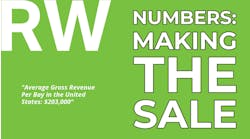SHOP STATS: Cars Automotive & Muffler Location: Redondo Beach, Calif. Owner: Michael and Gilda Dyckman Average Monthly Car Count: 185 Staff Size: 7 Number of lifts: 9 Shop Size: 6,0000 combined square feet ARO: $725 Annual Revenue: $2 million
SHOP STATS: Brotherhood Garage Location: Yukon, Okla. Owner: Brandon and Kayla Crusha Average Monthly Car Count: 500 Staff Size: 10 (1 manager, 1 service advisor, 1 shop foreman, 5 technicians, 2 general service technicians) Number of lifts: 6 Shop Size: 5,000 square feet ARO: $300-500 Annual Revenue: $1.1-1.5 million
Who, exactly, carries cash these days? Think about it. How often do your customers pay an invoice by cash (or by check, for that matter), rather than readying their credit cards for the chip reader or waving their phones over your POS terminal?
“We’re all seeing the pool of customers that pays in cash drying up and disappearing,” says Cecil Bullard, CEO of the Institute for Automotive Business Excellence. “Cash, for all intents and purposes, will be dead any day now.”
And while credit cards can be a major convenience to the customer—and an essential asset now that contactless service is our new way of life—the merchant processing fees that come with them have become an unpredictable and unavoidable cost of doing business.
Those fees will range by bank, credit card company, and processing partner but most shop owners pay a pretty high rate somewhere between 2.5 and 3.2 percent these days, Bullard says.
“That may not seem like much at first, but if I’m running a million-dollar shop and I’m totaling $800,000 in sales through credit card payments, even if I’m only paying a 2.5 percent fee on that profit, I’m missing out on $20,000 per year. Not to mention the extra fees that are going to pop up along the way,” he says.
And now, with shop owners embracing contactless options more than ever, the payment landscape is primed for processing fees to climb. So, how can shop owners keep their processing fees low and their profits high? Bullard and shop owners Gilda Dyckman of Cars Automotive & Muffler in Redondo Beach, Calif., and Brandon Crusha of Brotherhood Garage in Yukon, Okla., outline their best practices.
Take Time to Investigate
It may sound simple enough, but making a concerted effort to track and understand how your business utilizes credit cards is a key first step.
“These fees can seem like a small enough annoyance that you can set it and forget it, but if you’re not tracking and staying on top of that activity you’re just throwing money out the window,” Bullard says, recommending shop owners actually sit down to review their statements month after month.
From rollbacks of temporary sign-on rates to hidden fees to true purchase volume, shop owners need to pull reports and gather purchase and profit data to gain the full scope of how credit cards are used by the shop and its customer base and impacting the shop’s bottom line.
“When credit cards slowly climb to make up 95 percent as your customers’ preferred method of payment, it really paints a picture,” says Dyckman, who manages the books for her shop. “That’s intel I’ve got to be armed with as I consider any contracts [with banks or processing services] on the table.”
Cut out the Middleman
A move to explore options outside the traditional credit card processing model can help streamline shop systems and cut out added fees.
“Any additional convenience you enjoy as a consumer just bumps up the merchant fee for the shop owner when they process that card,” says Bullard. “Whenever I use something like Apple Pay or whenever you need to hand enter a card, there’s an extra fee for that. If a shop tries to go the touchless route and takes a credit card over the phone, that rate’s going to double and they’re automatically going to get charged the company’s highest fee, so it pays to cut out the middleman.”
For Dyckman, an investment in Facepay, a new contactless, mobile payment system that allows customers to use direct debit payments straight from their bank accounts, has been a boon for the business.
“When you’re paying a little over $3,000 a month in processing fees, it’s worth exploring new avenues,” she says. “We could hire a part time or full additional tech for that kind of money.”
With Facepay, Dyckman, who pays a 2 percent processing fee on average across the board when accepting other payment options, pays a small fee each month but is not charged processing fees for any payments taken through the system.
And for Crusha, a move to 360 Payments, an integrated system with multiple ways to pay, brought his processing fees from 2.6 down to 1.8 percent, saving him thousands since he started working with the company in 2018.
Look at the Big Picture
With no one-size-fits-all approach, a holistic look at the business can help identify options that may not offer the absolute lowest processing rate, but work best with existing shop processes.
“For some shops there are some non-negotiable specifics,” says Bullard. “For example, some processing companies will give you a lower rate but take longer to route the funds to your account. If you’re a small shop and you need funds fast, that’s going to be a dealbreaker.”
And in selecting Facepay “we looked into other options, but they would have cost us more overall with our shop set-up,” says Dyckman. “We would have been charged for access to each of our service stations and we’re committed to our wireless payment system. It just wasn’t worth it.”
At Brotherhood Garage, Crusha went through six processing companies in three years before landing on 360 Payments. The company was not only one of the options Crusha could integrate with his shop’s software system, but also offered the customer service support he’d been looking for through the years.
“They've designed everything to be actually easy to use and the few times we do need something, the support team actually has the power to help. I get to run my business instead of hounding them and that clinched it for us. That was our top priority” he says.
Open up a Dialogue
Bullard, Dyckman, and Crusha all agree consulting your peers and sharing notes can keep you up to speed on the latest rates and services and help you get the most from your processing partners.
Dyckman first heard of Facepay from a Facebook group discussion with fellow shop owners and Crusha’s helped fill his peers in on his experiences searching for the right fit for his shop, sharing the ups, downs and specifics that helped seal the deal and have paid off in the years since.
“When in doubt, I always recommend checking in with another reputable shop in town or consulting a 20 Group to see what they’re seeing, hearing, etc.," says Bullard. “When you can get 10 shops in a room to talk rates, everyone’s getting different rates and having different experiences, seeing success in different areas, and they’re all ready to share.”




